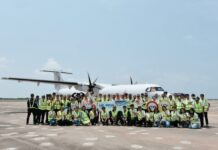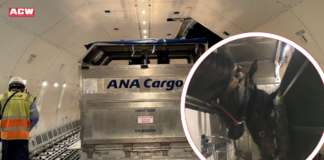

The last few years have posed a tricky time for a number of airlines and cargo operators, particularly those that operate in Asia but for Cathay Pacific, which calls Hong Kong home, their optimism and enthusiasm for the region hasn’t been dented.
“Cathay Pacific is a 75-year-old brand and Hong Kong has always been known as a central point,” Rajesh Menon, Regional Head of Cargo – South Asia, Middle East and Africa at Cathay Pacific Airways, said. “To be in a place where you become the carrier of choice, when it comes to cargo, Hong Kong is the ideal location for us.”
“We are proud to call Hong Kong our home because it remains a premier air cargo location,” Menon explained, highlighting how, out of the five million tonnes of cargo handled by the hub in 2020, Cathay carried 1.3 million tonnes of it.
Mixing passenger and cargo operations
While some airlines chose to focus on pushing resources towards passenger services or cargo operations, Cathay Pacific sees great merit in mixing the two. Instead of viewing one or the other as a side project, the airline recognises that both sides complement one another and help to bolster the airline as a whole. “As far as the importance of cargo is concerned, I think it’s been equally important,” Menon stated. “We are making business happen for us when it comes to cargo and the passenger side.”
With bellyhold capacity available for cargo on passenger routes, Cathay Pacific has added more flights for travellers domestically and internationally, helping it to cater to the growing demand for cargo transportation, as e-commerce booms and countries become increasingly interconnected.
This desire to merge the two sides of the airline into one cohesive unit is reflected in the company’s four-part vision: expertise, quality, innovation and people. “These are the four differentiators [between us and our competition] that we continue to invest and develop solutions for,” Menon added.
“An airline plays a vital role to the entire economic activities of a trading hub and region. That’s why we came in and that’s why we keep on investing because Hong Kong always wanted to see that economic growth. We saw that opportunity and we expanded around it.”
Read more: Hong Kong International Airport receives top billing by the Airports Council International
Collaborative and customer-centric
The recognition of the importance of collaboration within the airline’s own operation is carried over into its work alongside other parts of the airfreight industry. Having implemented Cargo iQ’s Freight into Warehouse control (FOW) and Freight out of Warehouse control (FOW), Cathay Pacific is focused on improving the visibility and efficiency of warehouse operations.
“Freight forwarders, GSAs, the trucking companies, everyone comes together to create process that is seamless,” Menon explained. “Through CargoiQ, we will build a process which is a recommended practice that lays out the standard and process, so that everyone is aware what is expected and all the stakeholders can actually see how things are happening.”
This level of collaboration throughout the logistics chain works to ensure that all elements are coordinating efficiently but also working to improve by sharing best practices. “Being a primary member who’s always been active in cargo, we really feel that the customer has the right level of transparency and complete visibility,” Menon said.
This ability to better tailor services to what customers are looking for is crucial to Cathay Pacific’s goal of becoming the world’s most customer-centric air cargo services provider, having been recognised in the past for its highly ranked operations throughout the challenging pandemic period. “The customer chooses his level of service and knows what he can expect from that. It could be the service or the ease. We are giving quality and standards in each level.”
Shaking off the impact of the pandemic
While passenger operations were particularly affected by Covid restrictions, seeing travellers grounded due to border closures, cargo continued to be an important performer for the airline, supporting it financially during a challenging period.
“Cargo was doing the normal business because Hong Kong is known as a trading zone. That continued and we were part of the whole journey, Menon said. “Over the last two years, airline cargo was the only thing that made revenue.”
Although the airline did experience a “small slowdown” because of the strict measures imposed on Hong Kong during the pandemic period, Menon was pleased to highlight how the situation is returning to a sense of normality.
In recently released figures, Ronald Lam, Cathay Pacific’s Chief Customer and Commercial Officer, laid out how the airline’s cargo volumes are 10% less than the same time in 2021, as they are now flying fewer cargo-only passenger services. Overall, the airline is now operating at around 63% of pre-pandemic cargo flight capacity, as of October.
“Our expanded network in Europe was a bright spot with double-digit month-on-month growth in October as we resumed more of our passenger services. This provided our cargo customers with more options, especially for specialised shipments such as pharmaceuticals,” Lam explained.
Read more: Cathay Pacific Cargo introduces Fly Greener
Continued growth
Having recently opened its newest facility at the Cathay Pacific Cargo Terminal – a fully temperature-controlled area dedicated to the handling of pharmaceutical products – the airline is committed to further investment in the region.
“There’s a quality and a commitment which we can give. Customers can choose and ensure what they are going to get with that,” Menon explained. “That’s why our motto is that we need to develop so we have solutions which are very customer centric.”
The Pharma Handling Centre, for example, now provides real-time temperature monitoring, a temperature-controlled dock shelter, multiple charging points and sustainable services. It’s also connected directly to the container handling system at the airport, ensuring prompt acceptance, storage and delivery.
“We just keep on upgrading our facilities,” he added. “I know for sure that our role will be much bigger and it’ll just continue to grow.”










